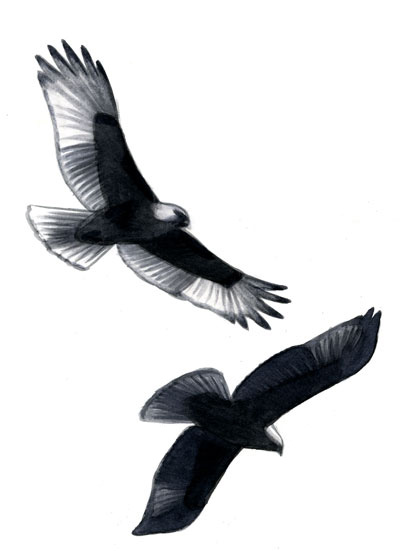
Patterns of translucence in wing feathers provide useful identification clues for many species of birds – terns, gulls, hawks, and others. Generally the translucent parts of the wing are those where there are fewer layers of feathers to block the light, and less pigment in the feathers. I’ve written about this before in my book Birding Basics and elsewhere, but I have just noticed another source of variation that I had not considered before.
I was enjoying a bright sunny morning a few days ago, watching two juvenile Red-tailed Hawks playing with each other in the air above me, and as they turned in flight it became apparent that their wings were strongly translucent at certain times and nearly opaque at others. A little careful observation revealed that the brightest translucence showed when the plane of the bird’s back was nearly perpendicular to the sunlight, and least when the plane of the bird’s back was closer to parallel with the sun’s rays.
It makes sense, but I had never thought of it before. As a soaring hawk turns in circles it will alternate between having the sunlight striking its back more or less perpendicularly, and then at the other side of its circle having the sun striking its wings more “end-on” at only a low glancing angle off the upper surface of the wings. It is in this latter position that little or no light comes through the wings.

It’s a small point, but something to keep in mind when watching a flying bird or comparing one bird to another.


Are you suggesting that the actual translucence changes between the two flight aspects, or simply the perceived translucence (meaning: what is seen by the human observer)? There are two angles to take into account: that of the bird to the sun, and that of the bird to the observer. It seems to me that if a raptor is circling, its angle to the suns rays shouldn’t change in reality (i.e., they should always be roughly ‘perpendicular.’ The raptor would have to fly upward or downward to fly ‘parallel’ to the sun’s rays, unless the sun is at a low angle). In this way, the situation could be somewhat akin to what you’ve been discussing recently with respect to iridescence: the angle to the observer, in addition to the angle to the light, is important to determine what is seen.
Hi Dan, I think the original post and artwork was not very clear, so I’ve just added a new diagram showing how the angle of the bird changes the angle of light striking the upperside. I hope this answers your question. There are other factors that come into play, such as whether the bird is backlit, the brightness of the sun and of the sky/cloud background, etc. but I think this angle makes a big difference regardless of other factors.
Thank you for sharing your knowledge of the Beautiful Creations God has Blessed us with … !!!